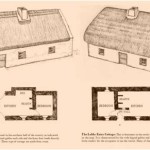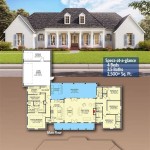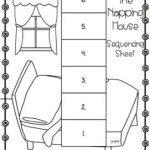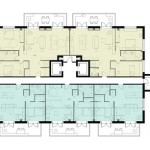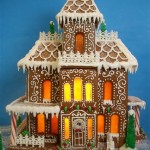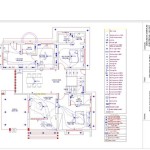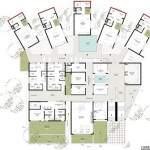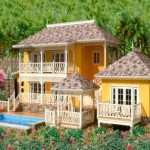House Plans With Inlaw Apartment Separate
The concept of accommodating multiple generations under one roof is experiencing a resurgence in popularity. This trend is driven by factors such as rising housing costs, the desire for closer family ties, and the increasing need for elder care. House plans with inlaw apartments, particularly those with separate entrances and distinct living spaces, cater to this demand by offering a balanced solution that promotes both independence and proximity.
Inlaw apartments, also known as accessory dwelling units (ADUs), granny flats, or mother-in-law suites, provide self-contained living areas within a larger residential structure. These units typically include a bedroom, bathroom, kitchen, and living area. The defining characteristic of a separate inlaw apartment is its independent access, ensuring privacy and minimizing disruption to the primary residence. This separation is crucial for maintaining a comfortable living arrangement for all occupants.
Selecting a house plan with a separate inlaw apartment requires careful consideration of various factors, including zoning regulations, building codes, family needs, and future resale value. Understanding these aspects is paramount to ensuring a successful and legally compliant construction project. Furthermore, thoughtful design choices are necessary to maximize functionality and create a harmonious living environment for all residents.
Zoning Regulations and Building Codes
Prior to embarking on any construction project involving an inlaw apartment, a thorough investigation of local zoning regulations and building codes is essential. Zoning ordinances dictate the permissible use of land and can significantly impact the feasibility of adding an ADU. Many municipalities have specific requirements regarding lot size, setbacks, parking, and maximum square footage for accessory dwelling units.
Building codes, on the other hand, establish minimum standards for construction safety, including structural integrity, fire resistance, and accessibility. These codes are designed to protect the health and safety of occupants. Meeting these requirements is not only a legal obligation but also crucial for ensuring the long-term integrity of the building. Failure to comply with zoning regulations or building codes can result in costly fines, delays, or even the forced removal of the inlaw apartment.
Furthermore, some areas may have specific regulations concerning occupancy of inlaw apartments. For example, there may be restrictions on renting out the unit to individuals outside of the immediate family. It's advisable to consult with local planning and building departments to obtain a comprehensive understanding of all applicable regulations before proceeding with the design and construction phases.
The process of obtaining the necessary permits can be complex and time-consuming. It's often beneficial to engage the services of an architect or contractor experienced in ADU construction to navigate the regulatory landscape and ensure compliance. These professionals can provide valuable guidance on design options, construction methods, and permit applications.
Design Considerations for Separate Inlaw Apartments
The design of a house plan with a separate inlaw apartment should prioritize both functionality and privacy. The separate entrance is the defining feature and should be strategically located to minimize disruption to the main house. Ideally, the entrance should be on a different side of the house or at the rear, creating a clear distinction between the two living spaces.
Interior layout is equally important. The inlaw apartment should be designed as a self-sufficient unit with its own kitchen, bathroom, living area, and bedroom(s). The kitchen should be equipped with essential appliances, such as a refrigerator, stove, and sink. The bathroom should be accessible and designed to meet the needs of the occupants, considering factors such as mobility limitations.
Soundproofing is another crucial consideration, especially if the inlaw apartment is located adjacent to the main house. Incorporating sound-dampening materials in the walls, floors, and ceilings can significantly reduce noise transmission and enhance privacy. Double-pane windows and solid-core doors can also contribute to soundproofing.
Accessibility should be a central theme in the design, particularly if the inlaw apartment is intended for elderly or disabled individuals. Features such as wider doorways, grab bars in the bathroom, and ramps or elevators can improve accessibility and make the living space more comfortable and safe. Universal design principles can be applied to create a home that is accessible to people of all ages and abilities.
Natural light and ventilation are essential for creating a comfortable and healthy living environment. Large windows and skylights can maximize natural light, while adequate ventilation can help to prevent moisture buildup and improve air quality. Attention should also be paid to energy efficiency, incorporating features such as energy-efficient windows, insulation, and appliances to reduce energy consumption and lower utility bills.
Storage space is another important factor to consider. Inlaw apartments often have limited square footage, so efficient storage solutions are crucial. Built-in cabinets, shelves, and closets can maximize storage space and help to keep the living area organized. Consider vertical storage solutions to make the most of limited space.
The aesthetic design of the inlaw apartment should complement the overall style of the main house. However, it should also have its own distinct character and feel. Using different paint colors, flooring, and décor can create a sense of separation and individuality. Allowing the occupants to personalize the space can enhance their sense of ownership and belonging.
Key Benefits and Considerations
House plans with separate inlaw apartments offer numerous benefits, including increased property value, rental income potential, and the ability to provide care for aging parents or other family members. The added living space can also be used as a guest suite, home office, or recreational area. However, there are also potential drawbacks to consider, such as increased property taxes, higher utility bills, and potential conflicts with neighbors.
One of the primary benefits is the financial advantage. Adding an inlaw apartment can significantly increase the resale value of the property. The potential for rental income can also help to offset mortgage payments or other expenses. Furthermore, having family members living on-site can provide opportunities for shared expenses, such as childcare or transportation.
Another key benefit is the enhanced flexibility and living arrangements. Inlaw apartments enable families to live together while maintaining their independence and privacy. This can be particularly beneficial for elderly parents who require assistance but still desire to live independently. It can also provide a supportive environment for young adults who are transitioning into adulthood.
However, it's important to acknowledge the potential challenges. Increased property taxes are a likely consequence of adding living space to a property. Utility bills will also increase due to higher energy and water consumption. Potential conflicts with neighbors can arise if the inlaw apartment is not properly managed or if it violates local regulations.
Managing the relationship between the occupants of the main house and the inlaw apartment is crucial for maintaining harmony. Clear communication, defined boundaries, and mutual respect are essential. Establishing ground rules regarding shared spaces, noise levels, and parking can help to prevent misunderstandings and conflicts.
Ultimately, the decision to build a house with a separate inlaw apartment is a personal one that should be based on careful consideration of individual needs, financial circumstances, and local regulations. Consulting with professionals, such as architects, contractors, and real estate agents, can provide valuable insights and guidance. By carefully planning and designing the inlaw apartment, homeowners can create a living space that enhances their quality of life and provides long-term benefits for the entire family.
The increasing demand for flexible housing solutions ensures the continued relevance of house plans with inlaw apartments. As families navigate the complexities of modern life, these designs offer a practical and adaptable approach to multi-generational living.

Find The Perfect In Law Suite Our Best House Plans Dfd Blog

Find The Perfect In Law Suite Our Best House Plans Dfd Blog

Find The Perfect In Law Suite Our Best House Plans Dfd Blog

House Plans With In Law Suites Houseplans Blog Com

House Plans With In Law Suite Floor Designs

House Plans With In Law Suites Houseplans Blog Com

House Plans With In Law Suites Houseplans Blog Com

Southern Style House Plan With In Law Suite

Front Side View House Plans With A Separate In Law Suite

House Plans With In Law Suites Houseplans Blog Com

